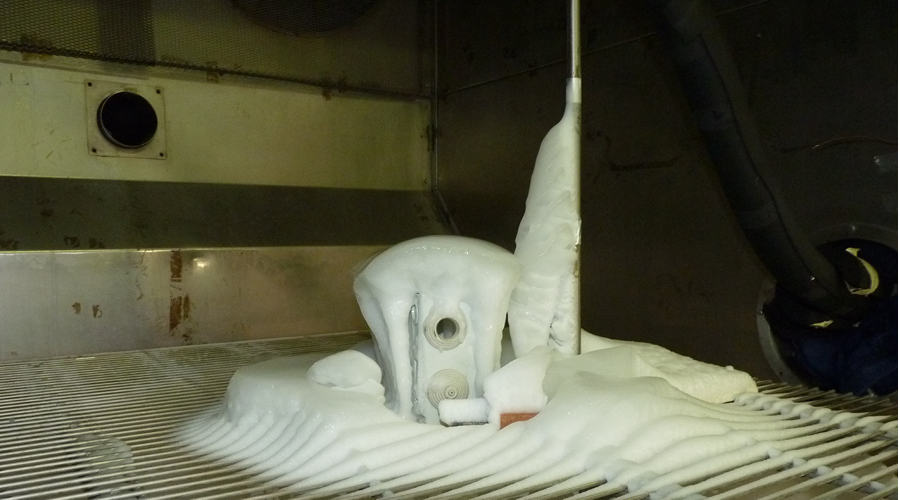Climatic tests:
your equipment to withstand extreme conditions
Climatic tests consist in reproducing the atmospheric environmental conditions encountered on land and at altitude. The aim is to simulate the same conditions, most often extreme, in order to measure the reaction of your equipment. The range of tests offered by Sopemea gives the possibility of reproducing all these conditions.
Your equipment tested:
hot, cold, sand, dust...


Sopemea has all the necessary equipment on its various sites to carry out your climatic test campaigns:
- Simultaneous combination of hot/cold atmospheric conditions, humidity, altitude, solar heating
- Rapid temperature variation (VRT) and thermal shocks
- Reproduction of storms: sand, dust, snow, rain
- Ice or frost deposition
- Salt spray
- Rapid decompression
- Mould growth or chemical attack by aggressive fluids
- IP rating tests of equipment enclosures against solid and liquid penetration
- Steam pipe rupture in a nuclear power plant (LOCA): thermodynamic pressure/temperature shock, saturated steam environment with boric acid spray
Testing facilities
to match your equipment


The available facilities (electrical power, frequencies of the 50Hz/60Hz/400Hz electrical networks, hydraulic pressures and flows, etc.) make it possible to carry out these tests on bulky equipment in their operational conditions.
These tests are carried out by qualified engineers and technicians.
We can also provide you with our expertise for specific tests.
Some tested
standards:


- CEI ou NF EN 60068-2-X
- GAM EG13
- NF EN ISO 9227
- MIL-STD 810G
- NF EN 2591-XXX
- RTCA DO 160G
- STANAG 4370
- RCC-E, IEEE...
Aeronautical testing
and their associated climatic test facilities:


Any qualification campaign must be carried out according to specific requirements or specifications and test standards (e.g. DO 160). Sopemea has all the testing resources required for these qualifications.
Depending on their position in the aircraft, some equipment will have to withstand very severe climatic conditions. By climatic conditions we mean all the parameters to which the aircraft will be exposed during its operation: temperatures, pressures, solar heating, rain, snow, frost, chemical attack, mould, corrosive atmosphere, etc. For example, during the take-off phase, the aircraft will be subjected to rapid variations in temperature, pressure, humidity, sunshine, rain, etc. These temperatures can then drop to -55°C, under a pressure of several tens of millibars.
In order to cover all possible cases, the statistical distribution of potential climatic conditions has been defined in standards, to be reproduced in test laboratories. The best known tests concern temperature and altitude, VRT (Rapid Temperature Variation), icing, susceptibility to fluids, mould and salt spray.
Our experts answer your questions
about climatic testing
-
What is a climatic test ?
The purpose of climatic testing is to simulate extreme environmental conditions in order to assess the reliability, durability and performance of your equipment. These tests are crucial before a product is launched on the market and throughout its life cycle. -
What type of climate testing does Sopemea offer ?
Sopemea offers a comprehensive range of tests to reproduce environmental conditions, such as Rapid Temperature Change (RTC), Salt Spray, IP Protection Rating and Thermal Ageing. We also carry out complex tests such as LOCA, Icing and Simultaneous Combination of Stresses (hot, cold, humidity, altitude and solar heating tests). -
What testing facilities do you have ?
Sopemea has all the testing facilities needed to carry out climate testing:
- More than 70 climate test chambers in France and the United Kingdom
- Climate chambers with exceptional characteristics, such as a 200 m³ chamber covering temperature ranges from -80° to 150°, including humidity and solar heating.
- Adapted utilities (electrical power, electrical network frequencies, hydraulic pressures and flow rates) enabling tests to be carried out on large equipment.
-
Do you carry out aeronautical tests ?
Yes, Sopemea is a major player in aeronautical testing.
We carry out equipment qualifications in accordance with industry standards.The tests cover the severe climatic conditions to which an aircraft is exposed, such as rapid changes in temperature and pressure, as well as altitude, icing, rain, snow and corrosion.
Choosing
Sopemea

A COMPLETE SERVICE OFFER ADAPTED TO YOUR NEEDS

MORE THAN 75 YEARS OF EXPERIENCE

A LOCAL NETWORK
Discover our
news

